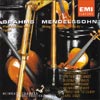Brahms Piano Quartet Op 26; Mendelssohn String Quintet Op 87
Fiery, intense performances from stars joining up for chamber masterworks
View record and artist detailsRecord and Artist Details
Composer or Director: Felix Mendelssohn, Johannes Brahms
Genre:
Chamber
Label: EMI
Magazine Review Date: 11/2004
Media Format: CD or Download
Media Runtime: 76
Mastering:
Stereo
Catalogue Number: 557799-2

Tracks:
| Composition | Artist Credit |
|---|---|
| Piano Quartet No. 2 |
Johannes Brahms, Composer
Christian Tetzlaff, Violin Hartmut Rohde, Viola Heinrich Schiff, Cello Johannes Brahms, Composer Lars Vogt, Piano |
| String Quintet No. 2 |
Felix Mendelssohn, Composer
Christian Tetzlaff, Violin Felix Mendelssohn, Composer Gustav Rivinius, Cello Hartmut Rohde, Viola Isabelle Faust, Violin Stefan Fehlandt, Viola |
Author: DuncanDruce
Over the past few years an impressive repertoire of recorded performances from the Heimbach Festival have appeared. The concerts take place in a hydro- electric power station, but if this suggests an over-resonant acoustic, that’s not apparent here; if anything the sound, though well-balanced, is somewhat dry, and the grander parts of the Brahms, the start of the finale, for instance, could have benefited from a more ringing sonority.
In such passages, I wondered whether Vogt, in his keenness not to over-pedal, wasn’t risking the opposite fault of sounding too clinically clear. But in general he and his three distinguished colleagues project both the work’s prevailing lyricism and more tempest- uous episodes like the Scherzo’s trio section.
The Mendelssohn is, I think, even more successful. There is fire and intensity in the outer movements, plus a thrilling momentum that thoroughly vindicates the finale, which can appear as one of the composer’s less inspired pieces. It’s very exciting to hear Mendelssohn’s brilliant writing for the two violins performed with such virtuosity.
The Adagio is wonderfully atmospheric, its Romantic gloom all the stronger because the preceding Andante scherzando is taken faster than usual. The Raphael Ensemble create more of a nocturnal impression in the Andante, and give greater emphasis to the first move- ment’s cantabile elements. But this account has its own view of the Quintet, presented so strongly and consistently as to make one wonder why it isn’t one of Mendelssohn’s most popular pieces.
In such passages, I wondered whether Vogt, in his keenness not to over-pedal, wasn’t risking the opposite fault of sounding too clinically clear. But in general he and his three distinguished colleagues project both the work’s prevailing lyricism and more tempest- uous episodes like the Scherzo’s trio section.
The Mendelssohn is, I think, even more successful. There is fire and intensity in the outer movements, plus a thrilling momentum that thoroughly vindicates the finale, which can appear as one of the composer’s less inspired pieces. It’s very exciting to hear Mendelssohn’s brilliant writing for the two violins performed with such virtuosity.
The Adagio is wonderfully atmospheric, its Romantic gloom all the stronger because the preceding Andante scherzando is taken faster than usual. The Raphael Ensemble create more of a nocturnal impression in the Andante, and give greater emphasis to the first move- ment’s cantabile elements. But this account has its own view of the Quintet, presented so strongly and consistently as to make one wonder why it isn’t one of Mendelssohn’s most popular pieces.
Discover the world's largest classical music catalogue with Presto Music.

Gramophone Digital Club
- Digital Edition
- Digital Archive
- Reviews Database
- Full website access
From £8.75 / month
Subscribe
Gramophone Full Club
- Print Edition
- Digital Edition
- Digital Archive
- Reviews Database
- Full website access
From £11.00 / month
Subscribe
If you are a library, university or other organisation that would be interested in an institutional subscription to Gramophone please click here for further information.





